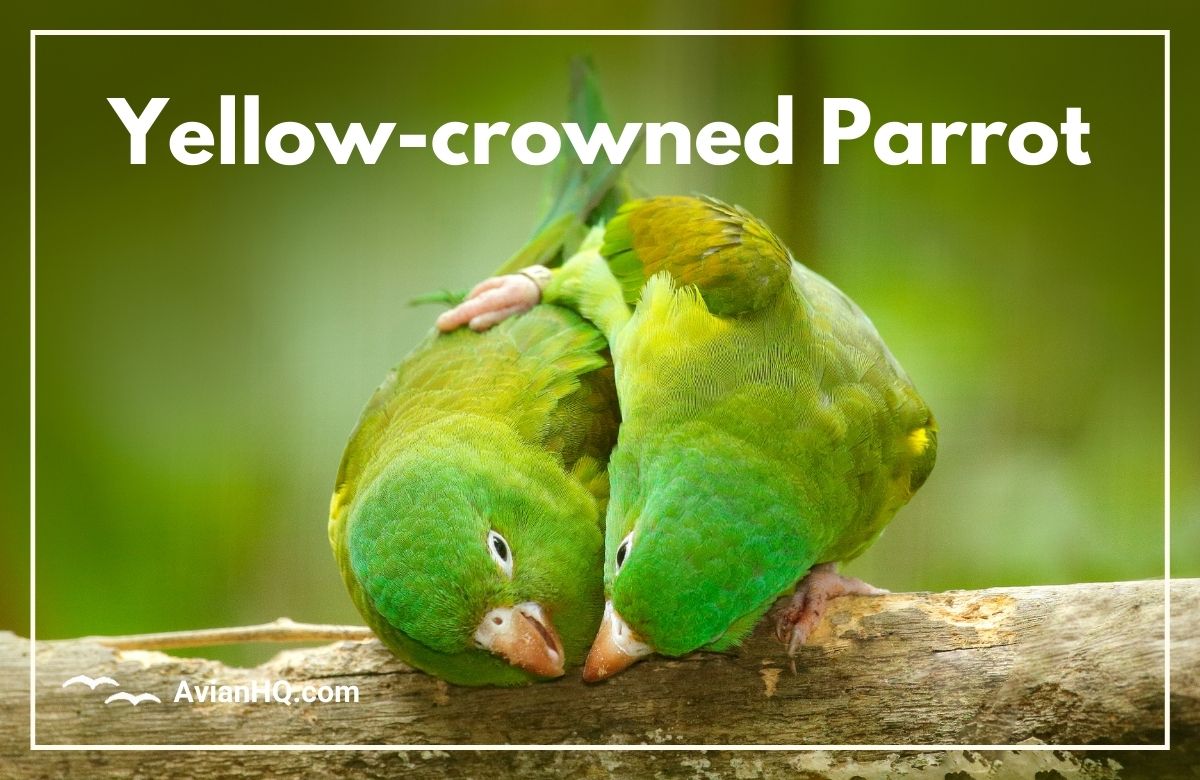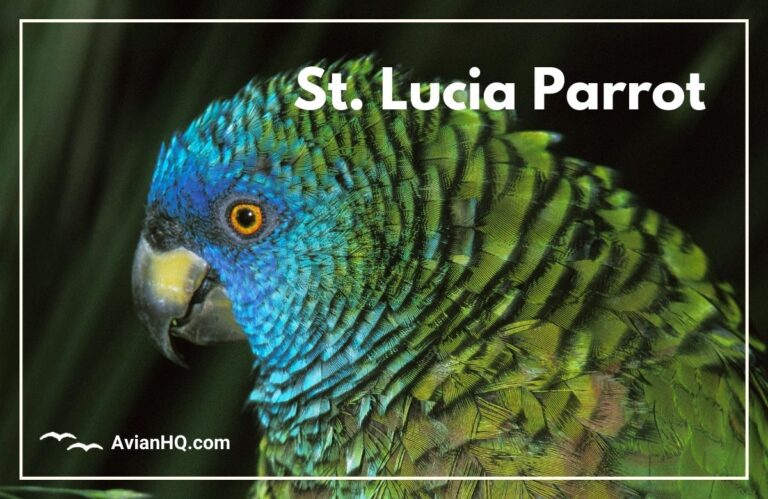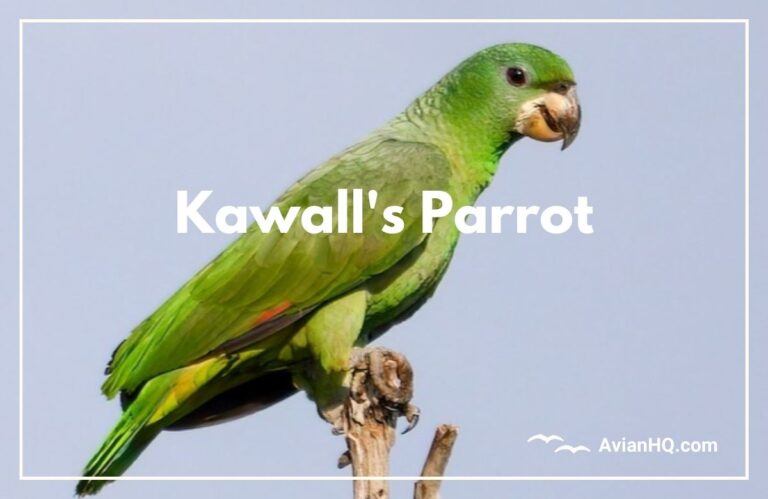Yellow-crowned Parrot (Amazona ochrocephala)
As you gaze up into the canopy of the tropical forest, a flash of green catches your eye. You spot a vibrant parrot with a striking yellow crown perched on a nearby branch. This social and vocal bird is likely foraging for it’s next meal, or keeping watch for predators. You have spotted the Yellow-crowned Parrot (Amazona ochrocephala), an iconic resident of Central and South American rainforests.
The Yellow-crowned Parrot is aptly named for the bright yellow feathers on the crown of it’s head.
Measuring 12-15 inches (30-38 cm) from beak to tail tip and weighing 13-17 ounces (380-500 grams), this mid-sized parrot makes it’s home in a variety of forested tropical habitats. It’s bright green plumage provides good camouflage among the trees and leafy branches. But that flash of colorful feathers on the head gives away it’s identity.
The Yellow-crowned Parrot has an expansive range spanning Panama, Colombia, Venezuela and across the Amazon basin countries like Peru, Ecuador and Brazil. It thrives in humid rainforests as well as drier, more open woodlands. Outside of mating season, these highly social birds gather in noisy flocks of up to 30 members. Their loud squawks and whistles echo through the tree canopy as they set out to forage fruits, seeds and flowers.
History and Taxonomy
The Yellow-crowned Parrot has a rich taxonomic history, with it’s scientific name tracing back over 200 years. It was first described in 1788 by German naturalist Johann Friedrich Gmelin. He officially named the species Psittacus ochrocephalus, grouping it within the parrot genus Psittacus which contained all known parrot species at the time.
The genus name Amazona was later coined in 1830 by French naturalist René Lesson, providing a distinction for these South American parrots. The modern scientific name Amazona ochrocephala combines Lesson’s Amazona genus with Gmelin’s original ochrocephalus species epithet. In Greek, the genus Amazona references the female warriors of Greek mythology, while ochrocephala means “yellow-headed” (ochros = yellow, kephalos = head).
Four distinct subspecies of the Yellow-crowned Parrot are currently recognized:
- A. o. ochrocephala – East Colombia and Venezuela through the Guianas and north Brazil
- A. o. xantholaema – Marajó Island at the Amazon River delta in Brazil
- A. o. nattereri – Southeast Colombia through east Peru and southwest Brazil
- A. o. panamensis – Western Panama to northwestern Colombia
Physical Appearance
The Yellow-crowned Parrot is a medium-sized rainforest parrot measuring 12-15 inches (30-38 cm) long from beak tip to tail tip. It weighs an average of 13-17 ounces (380-500 grams).
True to it’s common name, the bird’s most striking feature is the bright golden yellow feathers on the crown and forehead of it’s head. The rest of the plumage is primarily green, providing excellent camouflage. Blue feather tips adorn the wings and tail, while red feathers shine boldly on the bend of the wings and edges of the outer tail. The eyes are encircled by bright white rings of bare skin.
Males and females look nearly identical, however immature fledglings have less vibrant plumage, lacking yellow feathers on the head and red feathers on the wings. Their green body feathers also appear duller.
The four subspecies show some variation in size and plumage. A. o. panamensis is the smallest, while A. o. xantholaema has yellow plumage extending down to the nape of the neck. Meanwhile A. o. nattereri possesses blue-tinted feathers on the cheeks and throat.
All Yellow-crowned Parrots have sturdy hooked grey bills with a reddish-orange spot on the upper mandible. The irises of their eyes are orange and their legs and feet are grayish in color.
Habitat and Distribution
The Yellow-crowned Parrot naturally inhabits a wide swath of Central and South America. It’s range stretches from Panama down through Colombia and Venezuela, across the Amazon basin countries, and into the Guianas.
This species thrives in lowland tropical regions, mainly at elevations under 2600 feet (800 meters). It dwells in humid rainforests as well as drier, more open forests and savannas. Mangrove swamps, cultivated lands, and even suburban areas may also fall within it’s habitat range.
Introduced populations of Yellow-crowned Parrots now reside on islands like Trinidad and Tobago and Grand Cayman. Additionally, a group of about 60 escaped or released parrots has made it’s home in Stuttgart, Germany since the 1980s, apparently adapting well to the city’s urban parks and gardens.
Within their forested tropical habitat, Yellow-crowned Parrots tend to occupy the mid-canopy layer of trees. This allows them to blend in to the green leafy branches as they forage for food. It also provides open flyways below the highest treetops.
Diet and Feeding
The Yellow-crowned Parrot is an opportunistic and adaptable forager when it comes to dietary needs. This species is considered omnivorous, consuming a wide variety of both plant and animal material.
Fruits make up a major part of it’s nutrition. Wild individuals enjoy tropical fruits like mangos, papayas, figs, and palm fruits. They also relish cultivated fruits such as apples, oranges, bananas, and corn.
Seeds and nuts also contribute valuable fats and proteins to support the high energy demands of flight. Flower blossoms, buds, and tender new leaves round out the dietary staples. At times, the parrots may even sample insects, larvae, or snails for an extra protein boost.
Yellow-crowned Parrots often feed in small flocks or pairs. During fruiting seasons, larger congregations of up to 30 birds will gather at plentiful food sources. One unique feeding behavior involves gathering at clay licks beside river banks. There the parrots ingest clay, likely as a supplement to balance toxins from unripe or bitter fruit.
Breeding and Reproduction
The Yellow-crowned Parrot breeds during the rainy season between December and May across most of it’s range. Pairs form strong monogamous bonds and work together to prepare nests for raising young.
Nests are made in the hollows of tall rainforest trees, often at heights over 65 feet (20 meters). Pairs also nest in palms, dead termite mound cavities, and sometimes even buildings or structures.
Once bonded with a mate, the female typically lays a small clutch of 2-3 white eggs roughly 1.5 x 1.2 inches (37 x 30 mm) in size. She incubates the eggs for about 26 days while the male helps guard and bring food.
The altricial hatchlings are born featherless and helpless. Both parents share duties feeding the chicks a nutritious diet of pre-digested fruits and seeds. After 8-9 weeks in the nest, the juveniles are ready to fledge. They remain closely associated with their parents for several more weeks as they learn to forage on their own.
Behavior and Ecology
The Yellow-crowned Parrot exhibits highly social behaviors, gathering in noisy flocks when not breeding. Mated pairs may remain together for life, communicating with an array of vocalizations and even distinct dialects in some regions.
Flock sizes range from pairs up to about 30 individuals outside of breeding season. Larger congregations may amass at abundant food sources or communal roosting sites. Flocks utilize cooperative behaviors while foraging, keeping watch for threats, and calling out alerts.
Roosting patterns reflect the fission-fusion style seen in many highly social bird groups. Core pairs or small flocks may merge together into larger roosting flocks at night. Then subgroups break away again to forage independently during the day.
Vocalizations play a key role in communication and social interactions. Both males and females use unique calls when courting potential mates. Syntax and dialect differences even arise between distinct regional populations. And pairs vigorously defend nesting territories, chasing away intruders with aggressive displays and vocal warnings.
Beyond loud squawks and whistles, some individuals demonstrate an uncanny ability to mimic human speech when kept as pets. Their high level of intelligence shows in aspects of foraging strategies, communication, and adaptation to habitats disturbed by human activities.
Conservation Status
The Yellow-crowned Amazon Parrot is currently classified as Least Concern on the IUCN Red List of Threatened Species. It’s extensive habitat range and sizable global population provide some buffer against extinction risks.
However, experts believe overall populations are in decline in many areas due to continued habitat destruction across the Neotropics. The illegal pet trade also fuels heavy trapping pressures, as this species remains in high demand.
Fledglings are particularly vulnerable to poaching for the pet trade. Unscrupulous trappers will remove nestlings just days old to be hand-raised and sold. Such activities decimate recruitment levels and reproductive success.
Protection efforts now center on anti-poaching enforcement and habitat preservation. Several reserves exist across the Yellow-crowned Parrot’s range to safeguard critical nesting and foraging grounds. But more work is needed to limit trapping and curb rates of forest loss to agriculture and logging.
Targeted conservation plans also aim to track population densities and trends while also developing sustainable ecotourism practices. As charismatic rainforest inhabitants, Yellow-crowned Parrots have potential to serve as “umbrella species”, protecting not just their own futures but entire ecological communities.
Conclusion
The Yellow-crowned Amazon stands out as one of the most recognizable and iconic rainforest parrots of Central and South America. It’s vibrant green plumage accented in bright flashes of yellow, blue, and red makes it a prized species in captivity. And it’s loud vocalizations and high level of intelligence demonstrate advanced social behaviors and adaptability.
While still relatively widespread across it’s native habitat range, experts fear for the future prospects of Yellow-crowned Parrot populations. Rates of habitat loss, trapping for the pet trade, and natural threats like nest predation are taking a cumulative toll over time. Proactive conservation plans aim to study and monitor wild numbers while also engaging local communities. The hope is that increased ecotourism and enforcement efforts can help safeguard populations across this species’ range.
In the end, the fate of the Yellow-crowned Parrot remains intertwined with the future of the tropical forests it calls home. As sentinel inhabitants of these threatened wilderness habitats, it’s persistence may well indicate the health and preservation of entire ecological communities. The vibrant calls of Yellow-crowned Parrots reverberating through protected rainforest canopies could signify hope for a brighter outlook.








https://app.roll20.net/users/16055866/kelly-k
https://bandori.party/user/284201/roscargr/